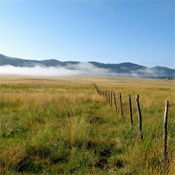Quoted from: Technical Description for CLM4.5 https://www.cesm.ucar.edu/models/cesm1.2/clm/CLM45_Tech_Note.pdf
The motivations for the development of CLM4.5 (the model version described in this Technical Description) were similar to those for CLM4: (1) incorporate several recent scientific advances in the understanding and representation of land surface processes, (2) expand model capabilities, and (3) improve surface and atmospheric forcing datasets.
Specifically, several parameterizations were revised to reflect new scientific understanding and in an attempt to reduce biases identified in CLM4 simulations including low soil carbon stocks especially in the Arctic, excessive tropical GPP and unrealistically low Arctic GPP, a dry soil bias in Arctic soils, unrealistically high LAI in the tropics, a transient 20th century carbon response that was inconsistent with observational estimates, and several other more minor problems or biases.
The main modifications include updates to canopy processes including a revised canopy radiation scheme and canopy scaling of leaf processes, co-limitations on photosynthesis, revisions to photosynthetic parameters (Bonan et al. 2011), temperature acclimation of photosynthesis, and improved stability of the iterative solution in the photosynthesis and stomatal conductance model (Sun et al. 2012). Hydrology updates include modifications such that hydraulic properties of frozen soils are determined by liquid water content only rather than total water content and the introduction of an ice impedance function, and other corrections that increase the consistency between soil water state and water table position and allow for a perched water table above icy permafrost ground (Swenson et al. 2012). A new snow cover fraction parameterization is incorporated that reflects the hysteresis in fractional snow cover for a given snow depth between accumulation and melt phases (Swenson and Lawrence, 2012). The lake model in CLM4 is replaced with a completely revised and more realistic lake model (Subin et al. 2012a). A surface water store is introduced, replacing the wetland land unit and permitting prognostic wetland distribution modeling, and the surface energy fluxes are calculated separately (Swenson and Lawrence, 2012) for snow-covered, water-covered, and snow/water-free portions of vegetated and crop land units, and snow-covered and snow-free portions of glacier land units. Globally constant river flow velocity is replaced with variable flow velocity based on mean grid cell slope. A vertically resolved soil biogeochemistry scheme is introduced with base decomposition rates modified by soil temperature, water, and oxygen limitations and also including vertical mixing of soil carbon and nitrogen due to bioturbation, cryoturbation, and diffusion (Koven et al. 2013). The litter and soil carbon and nitrogen pool structure as well as nitrification and denitrification are modified based on the Century model and biological fixation is revised to distribute fixation more realistically over the year (Koven et al. 2013). The fire model is replaced with a model that includes representations of natural and anthropogenic triggers and suppression as well as agricultural, deforestation, and peat fires (Li et al. 2012a,b; Li et al. 2013a). The biogenic volatile organic compounds model is updated to MEGAN2.1 (Guenther et al. 2012)
Additions to the model include a methane production, oxidation, and emissions model (Riley et al. 2011a) and an extension of the crop model to include interactive fertilization, organ pools (Drewniak et al. 2013), and irrigation (Sacks et al. 2009). Elements of the Variable Infiltration Capacity (VIC) model are included as an alternative optional runoff generation scheme (Li et al. 2011). There is also an option to run with a multilayer canopy (Bonan et al. 2012). Multiple urban density classes, rather than the single dominant urban density class used in CLM4, are modeled in the urban land unit. Carbon (13C and 14C) isotopes are enabled (Koven et al. 2013). Minor changes include a switch of the C3 Arctic grass and shrub phenology from stress deciduous to seasonal deciduous and a change in the glacier bare ice albedo to better reflect recent estimates. Finally, the carbon and nitrogen cycle spinup is accelerated and streamlined with a revised spinup method, though the spinup timescale remains long.
Finally, the predominantly low resolution input data for provided with CLM4 to create CLM4 surface datasets is replaced with newer and higher resolution input datasets where possible (see section 2.2.3 for details). The default meteorological forcing dataset provided with CLM4 (Qian et al. 2006) is replaced with the 1901-2010 CRUNCEP forcing dataset (see Chapter 26) for CLM4.5, though users can also still use the Qian et al. (2006) dataset or other alternative forcing datasets.
CLM4.5 was released to the community in June 2013 along with the Community Earth System Model version 1.2 (CESM1.2).








